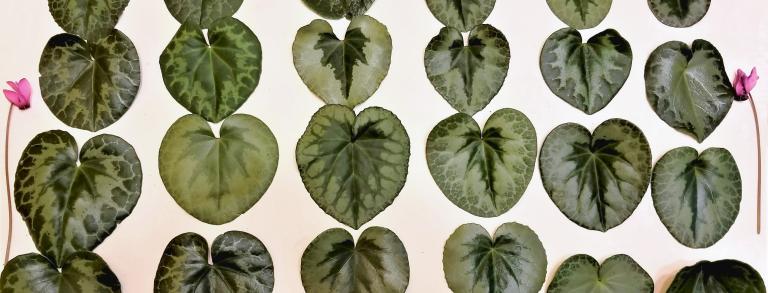TURNING THE CORNER in a woodland path at the Denver Botanic Gardens many years ago, I was blown away by hundreds of blooming cyclamen seemingly thrown down like a Persian carpet beneath the trees. A wild array of leaf patterns made each plant glow like a piece of carved jade. From that moment, it became an obsession to find out the secret for such rich abundance in a cold climate.
Who hasn’t admired the potted cyclamen that must be wintered indoors? These cyclamen are derived from Cyclamen persicum, which still adorns the mountains of Persia (modern-day Iran). It, and the many species that are widespread in Europe and Asia, often grow in woodlands. Chasing a Minnesota hardy species has led down many a dead end. I won’t bore you with the details of the species I have tried that wasted time, money, and emotion.
The elusive plant was right under my nose all the time. Cyclamen purpurascens is the sole cyclamen that I have found reliably hardy here (Minneapolis, Minnesota) without winter cover. In addition, it displays its beautiful leaves and flowers all summer, not going dormant like most others. However, just like a lot of desirable plants, C. purpurascens must be happy in the summer to be hardy in the winter. I had tried this species before, putting it in rich soil in shade. It dwindled and finally expired. Imagine my delight the next spring, as I was tidying up a patch of Epimedium × rubrum across the yard, when I found two cyclamen seedlings flourishing under its leaves. Ants must have carried the cyclamen seed across the yard from the now-deceased mother plant. They were tucked in among the epimedium roots, certainly a dry spot. That was my first hint that, just like rhododendrons, the first rule of cyclamen growing is drainage.
Coincidentally, that fall three years ago, I was given a generous amount of seed. Planted in humus-rich but gravelly soil in pots in the greenhouse they rested until spring and then started to germinate, more and more every day. There were literally hundreds of them by May! What to do with them? A few were planted around my home in garden soil, but the bulk of them went to my rhododendron garden across the street.
When I purchased that property five years ago, it was pure sand under a forest of white oaks. We covered the gardens-to-be one- to two-feet (30-60 cm) deep with wood chips, watered and fertilized the area and let the chips decay. The soil became like chocolate cake and plants could be dug up with your hand. Rhododendrons on trial take up the center of the beds, but the edges, next to the logs marking the paths, turned out to be the perfect place to line out the cyclamen. Each plant was only as big as my thumbnail, but in expectation of future growth, they were placed six inches (15 cm) apart.
That first summer, it was clear that something was going on. By August the plants were as big as my palm, and a few were blooming! Meanwhile, the plants in rich garden soil with clay were merely surviving. They were only small novelties to be pointed out, whereas those growing in the woodland soil attracted attention on their own for their lush leaves and flowers.
Last spring, after a hard winter with little snow, I watched them with trepidation, hoping to find a few hardy ones. However, every single one of the plants in the woodland soil survived and soon started blooming! Individual plants were in bloom from May to November, and many rebloomed. Seedlings from the previous year emerged and were transplanted to expand the beds. Best of all, the leaf patterns varied from highly marbled, to “Christmas Tree” forms with the center an image of a tree or maple leaf, to solid silver and all manner of individual variation. Flower color varied from pink to ruby, so the plants brought plenty of variety to satisfy my collector instinct.
If you plan to try these special plants, keep in mind that they do best in a well-drained, but moisture-retentive soil. A balance of air and moisture in the pore spaces of the soil is ideal: chocolate cake, not fudge! Choose a spot in filtered light or morning sun, or in the reflected light from a lawn on the north side of a building or evergreen. If the soil is sandy, add leaf mold to make a bed at least a foot deep. If your soil is clay based, make a raised berm edged with logs or rocks that will allow excess water to drain away. Watering in drought conditions will keep leaves turgid and plants producing flowers. Otherwise, life will retreat to the bulb to await a better day. In the right conditions, bulbs have grown from pinhead to teacup size here in just a few years.
One of the fascinating things about cyclamen is the cunning way they plant their own seeds. Really. Once the flower is pollinated, the stem begins to curl downward, ending up in a tight coil surrounding the seed and tucked into the base of the leaves. There, the seed is safe from birds, but ants often carry it far away for its attendant nectar. That is how cyclamen disperse. In May, as the spring uncoils and the stem straightens downward, the seed is driven into the ground near the parent plant, thus creating one of those wonderful carpets I first saw in Denver.

